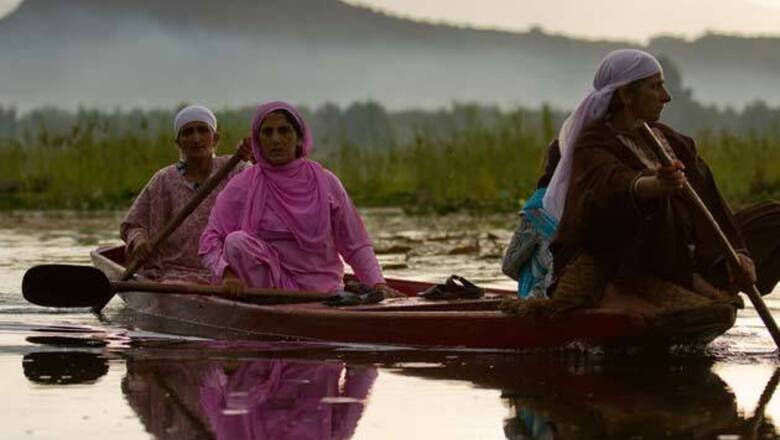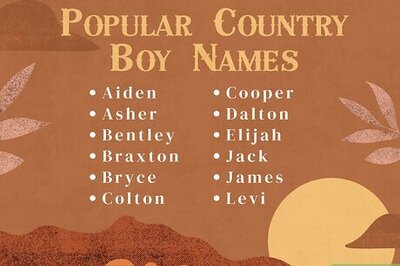
views
New Delhi: Valley of Saints, Musa Syeed's first feature film will premiere at the Sundance Film Festival which begins on January 19, 2012. The film was shot in Kashmir during the peak of unrest in 2010. It tells the story of a boatman who wants out of Kashmir but a beautiful young woman researching the dying Dal lake leads him to contemplate a different future.
Later this month, the film will have a screening in the Bright Future section at International Film Festival Rotterdam.
Musa Syeed is an independent writer and filmmaker of Kashmiri origin based in New York. He received the Alfred P. Sloan Feature Film Production Award for his screenplay of Valley of Saints. His documentaries titled Bronx Princess and A Son's Sacrifice have travelled to several international film festivals like Berlinale, Tribeca and International Documentary Festival Amsterdam. Syeed talks about Valley of Saints and the process of shooting it in Kashmir…
What was the inspiration to make this film?
As a child, my parents always talked about how beautiful Kashmir is. In their minds, no other place could match it. So, I was always curious to see Kashmir's lakes, hill stations, and gardens. I heard a lot about Dal Lake in particular, and so I wanted to get to know this unique water-world. I was interested in the relationship between people and their environment, and how the state of the lake reflected Kashmiri society and history. The lake proved to be a visually rich and compelling setting, and I knew I had to make a film there.
The environment provided an alternative way of exploring Kashmir, as the region is usually looked at solely through the conflict. This also allowed me to take on a more positive, vibrant tone than is usually associated with the valley.
So, what is unique to the film with regard to Kashmir in backdrop?
When looking at Kashmir, the idea that struck me the most is the resilience of the place and its people. Even In the face of destruction, people find ways to embrace life, love, and hope. The environment, too, is still beautiful, and even though it's not what it used to be, there is something there to be cherished and preserved. The central idea is true not just of Kashmir, but any place: we can't get back what is lost, but we can nurture what remains.
How was the experience of shooting the film at a time of high unrest in Kashmir in 2010?
Just a few weeks before our planned shoot, the unrest really broke out. A lot of people advised us not to go ahead with our plans, but my instincts told me to go. I rewrote the script, incorporating the curfew and protests into the script. Having to start over actually helped me move away from the complications of my previous script, and instead I had to refocus on creating strong characters and exploring their relationships. I found myself wondering about what happens to friendship and romance at a time like this. This process certainly made the film a lot more human.
It was unsettling at times to hear tear gas shells and bullets fired in the distance, but it also made me feel even more of an urgency to tell this story. So while at first it seemed like bad luck, in the end I was grateful to be able to make a film during that time. By embracing the reality of what was going on, I was able to tell a more organic, authentic story, rather than imposing my own narrative.
What were the logistical challenges of shooting it there?
Because of the unrest, we didn't feel safe bringing a large crew, so only my producer (who also recorded sound), my cinematographer, a local PA and I made up the entire crew. We often didn't know what we would be able to shoot from day to day, so we were often caught producing the next day's shoot the night before.
While we were on Dal Lake, we were mostly out of harm’s way. As a tourist safe haven, we were free to move around, and we had most of the resources and locations we needed to shoot. I had spent a lot of time with the community of boat people there, and so we were trusted and supported. But at times we had to venture into the city, when there were off days from the curfew, and that's when we ran into trouble. During one shoot, some youngsters started throwing stones at us, mimicking the protesters in the streets, and they injured Gulzar, our lead actor. It turned out not to be so serious, but it certainly worried me at the time.
You have worked on documentary films before. How did you find the shift from documentary to fiction?
The film's cinematographer Yoni Brook and producer Nicholas Bruckman also have a background in documentary, and that certainly helped us shoot in unpredictable and uncontrollable environments. While many fiction filmmakers may feel the need to always control a set, we were open to anything. For example, we were able to shoot a scene in the actual floating vegetable market on Dal Lake, capturing this unique spectacle in a very authentic way.
What is the visual style of the film like?
The inspiration for the film is Kashmir's natural beauty, and the Dal Lake in particular. I wanted the camera to be fluid, like the water we were shooting on, which resulted in a more lyrical, poetic style. I also wanted the film to feel very naturalistic, so audiences would feel the immediacy and reality of the time and place we were making the film, so we also adopted a more observational/documentary approach to capture some of the life in and around the lake.
As you are an independent filmmaker, how easy or difficult was it to secure funding for the project? How far did the Sloan Producer's Grant help?
We were able to raise enough funding through grants, including two grants from the Sloan Foundation. It was difficult to raise money from investors–the film was risky in a lot of ways. We weren't working with big-name, professional actors, and we were shooting in an unpredictable place. I was disappointed that we weren't securing investments, but my producer Nicholas Bruckman reminded me that without investors, I had no one to answer to. I could make the film exactly how I wanted to. Being able to take creative risks is the most satisfying part of filmmaking, especially when those risks pay off.
How do you feel about your film premiering at Sundance?
We're very grateful to be premiering at Sundance. It's been a dream of mine for some time, and I still can't fully believe it. Not many people have seen the film, so I'm curious to talk to audiences about the film. And I think the festival will really help us find ways of getting the film out to the larger world.
Tell us something about your personal background. What's your connection with Kashmir?
Both my parents were born in Kashmir, but after they moved to America, we didn't grow up around many Kashmiris. We didn't go back to visit either, except once when I was very young. So, I didn't have a real connection with Kashmir until more recently. As an adult, I had been thinking more about my place in the world, about my roots. I wanted to reconnect with Kashmir, a place I had only heard about in stories. So, for the first time in nearly twenty years, I went back to Kashmir on my own.
For me, making a film is a very immersive process, and that helped me move beyond my comfort zone to really get to know Kashmir. In particular, the summer I spent getting to know the community of boat people on Dal Lake was very special. These were people I had no connection to, but they indulged my curiosity and took me in. I think in some ways they took pity on me, and they wanted to help reconnect me to my roots.
I didn't speak any Kashmiri when I started the film, but it was important to me to have all the dialogue in Kashmiri. So I sat through all the translation of the dialogue, watching how things translated word for word, so I knew how each line should be performed. I have to say, I think it's the best way to learn a language.
What are you working on next?
I'm considering doing more projects in conflict areas, because, like Kashmir, they often don't have a relatable human face. In particular, I would like to do a project in Afghanistan.
At the same time, I'd like to do something stylistically very different. I just finished another feature script, which is a kind of dark comedy-musical, set in New York, in case I don't want to travel again too soon.
An introduction to the cast of the film?
Gulzar Ahmad Bhat is a boatman and resident of Dal Lake, Kashmir. He plays Gulzar, the leading role in Valley of Saints. I discovered Gulzar through a long, embedded casting process in the Dal Lake boatmen community during 2009. After I worked, ate and slept under the same mosquito net with him, I chose Gulzar for his charisma and powerful performances drawn from real life experience.
Afzal Sofi is a journalist and Masters student at the University of Kashmir. He plays Afzal, Gulzar's best friend in Valley of Saints. Originally brought on the team to translate Kashmiri dialogue for the film and coach actors, Afzal quickly developed a tender but bullying friendship with real life Gulzar. As I observed how the script was reflected in their natural (and often hilarious) chemistry, Afzal was cast in this major supporting role.
Neelofar Hamid is a professional actress in Kashmiri TV series and commercials. She plays Asifa, the scientist and leading female role in Valley of Saints.
Casting Asifa was an immense challenge due to the cultural taboo against female actors in Kashmir. We turned to the small, struggling acting community in Srinagar, where the main livelihood is in melodramatic Kashmiri soap operas. After many auditions with actresses who could not break out from that style, I met Neelofar. Neelofar's intelligence and independent spirit matches Asifa's, giving her the range to perform the role with nuance and authenticity.
####



















Comments
0 comment